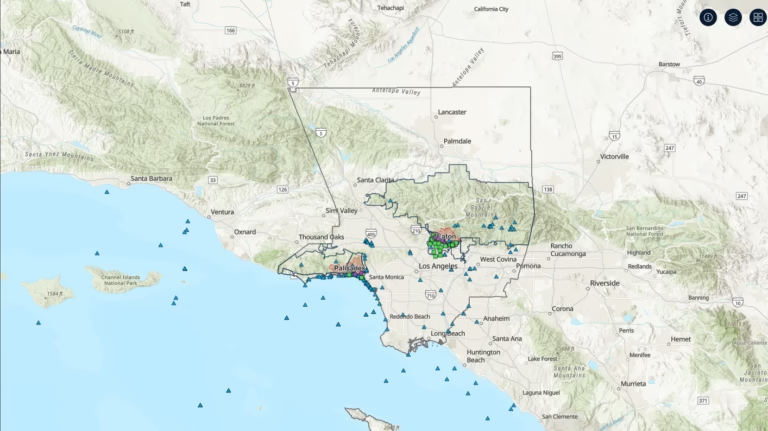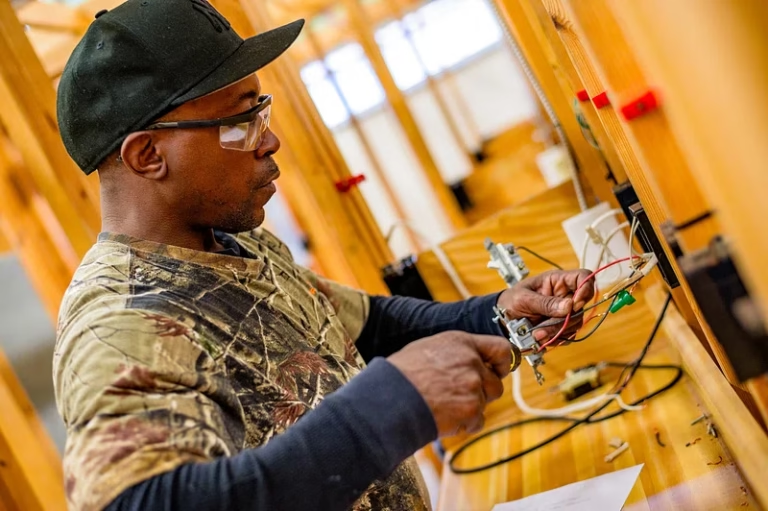Trump’s War on Truth and the Fight to Make Polluters Pay
Trump’s embrace of climate denial—calling the climate crisis “a hoax”— echoes his embrace of birtherism: He makes broad, sweeping statements without the slightest effort to learn the underlying lies, much less the truth. But he can only do so because of what he’s trying to hide.
This helps explain why some environmental activists—like Peter Warren, with Indivisible San Pedro since its beginning—have shifted focus to fighting him and his allies on whatever front seems most promising, while others have stayed focused on more specific battles. Sherry Lear, with 350.org Southland Legislative Alliance, has focused on state-level policies, seeking to make California live up to its self-image of environmental leadership. “It’s hard enough to get stuff done with the Democrats that are supposed to be the good environmentalists, so I ain’t gonna put Trump’s issues on top of that,” Lear said. “That is way overwhelming.”
Lear referenced the Sierra Club’s 7-page legislative Priority List, which covers more than 30 bills, including 3 directly responding to the wildfires and seven that seek to undermine CEQA, the state’s premier environmental protection law. There’s a lot to be concerned about, she warned. But there’s also the “Make Polluters Pay Bill,” which “will basically look at the greenhouse gas emissions of companies that create the most pollution and then create a climate Superfund,” she explained. “So it’s literally what it says. It’d make polluters pay.” It’s supported by a big coalition but requires a two-thirds majority for it to pass. So it will be a major battle.
Here in the San Pedro Harbor, both ports are eagerly welcoming green transition grants on one hand, while fighting against pollution limits in a prospective Independent Source Rule from the South Coast Air Quality Management District. And so activists are fighting back. While the ports have non-binding goals under their Clean Air Action Plan, an ISR could require mandatory reductions, which they’ve long opposed.
“The draft rule doesn’t go far enough, because it’s really just asking ports to do the planning that they should be doing anyways,” said Fern Uennatornwaranggoon, with Pacific Environment. “It’s not actually looking to set emissions reductions targets, to really get ports to, in concrete ways, start reducing emissions.” The rule reflected the recognition that “while emissions have decreased in the 2000s, they have stagnated for about a decade now,” she said.
“They got all the low-hanging fruit in the first eight years,” Warren noted, and in addition, “They refused to set periodic goals,” he said. “There were no way stations along the way, metrics to say ‘here’s how far we’ve come in five years, we better move a little faster,’ ‘here’s how far we’ve come in 10 years, we better do more.’”
The National Battle: Trump As A Climate Menace
But mostly Warren’s focus has been national since 2017. He calls Trump “a menace” on climate, but it goes even deeper, to “Trump doesn’t believe in the truth,” he said. “He believes if you can hide the truth, if you don’t look at the truth, you can proceed as if everything is fine. So on that level, he’s a menace.”
As an example, Warren pointed to the recently announced cuts for funding the once-every-four-year National Climate Assessment. That same day, Science magazine reported an even more sweeping cut planned in Trump’s budget proposal: The virtual elimination of the Office of Oceanic and Atmospheric Research, which “would send the United States back to the 1950s,” according to one expert.
And the day before that, ProPublica reported that Trump’s EPA plans to stop collecting greenhouse gas pollution data from most sources—thousands of them, “including oil refineries, power plants, and coal mines as well as those that make petrochemicals, cement, glass, iron, and steel.”
Climate denial has been around for decades, but this is climate refusal: refusing to even collect evidence, much less look at it.
This comes just three months after Britain’s Institute and Faculty of Actuaries warned that the global economy could face a 50% loss in GDP between 2070 and 2090 from climate shocks, along with billions of deaths, and just days after a top insurer warned that “At 3C of global heating…. capitalism as we know it ceases to be viable.”
In short, a renewable energy transition is a basic economic requirement.
Port Zero-Emissions Grant Seems Safe, But…
Just days before the November election, the Biden administration announced a $412 million EPA grant for zero-emissions investments at the Port of LA. But given Trump’s ongoing efforts to take back $20 billion in EPA funding in another funding stream, there was initial trepidation that funding could be in trouble. But the port says that has passed. “We’ve had a virtual meeting with EPA officials and as of today, the grant is moving forward as planned,” port spokesman Phillip Sanfield told Random Lengths. “The Port has received one small reimbursement thus far and we plan to begin moving forward with projects later this year.”
While most of the funds go to five terminals ( nearly 425 pieces of cargo-handling equipment, 300 charging ports and related infrastructure, and 250 drayage trucks) there is also a significant community grant that would be administered by the Harbor Community Benefits Foundation. “There is up to $50 million as part of this program to be used for a community workforce development program, a community benefits zero emissions grant program, and a community engagement program to inform the community about what’s going on with all this,” HCBF board chair Ed Avol told Random Lengths. They’re in negotiations with the city attorney, and expect it to go through, but aren’t taking any steps yet that rely on it.
After nine funding rounds, they were about to close down when another $3.2 million became available from Trapac, and “our intent is to get these funds out as quickly as we can,” Avol said. But, “In the past year, we’ve had some difficulty” getting the Port Of LA board to sign off on some grants, with back-and-forth discussions dragging on for months. There’s even one last grant funding the community garden which was turned down because the city attorney said it conflicts with a city statute.
“But that was confusing to us,” Avol said, since “we have funded the community garden on at least two previous occasions, and the port has approved and funded that.” They’ve pushed back and the city attorney is currently reviewing the matter.
If the EPA grant comes through — “there is some skepticism,” Avol cautions — but “That would be a dramatic increase upon what even done over the last decade of our existence.” In that case, they would have to expand their staff, starting with a new executive director. It’s quite a turn-around since the end of last year when they were looking at closing up shop.
But even with the EPA grants coming through, and the substantial ZE equipment purchases, Trump’s recent tariff war tantrum — with up to 145% tariffs on Chinese goods — has introduced dramatic uncertainty.
“If I were an investor I’d be sitting there on pins and needles…. I would hold back,” said June Smith, former chairperson of the Port Community Advisory Committee. A life-long environmental activist, she also has a business background as a buyer for Macy’s before going into academia. “I don’t see how these investors can be assured that they’re not going to lose their money,” she said.
Uennatornwaranggoon agreed about the potential decline in port climate investments and added another concern: Trump’s stop-and-go antics “just creates more uncertainty, and supply chain uncertainty creates inefficiency at ports,” quite possibly leading to waves of waves of congestion when tariff conditions seem favorable, and slack when they don’t. In addition, Longshore workers would be impacted directly, but communities would suffer as well since more congestion means more pollution.
Still, with POLA’s EPA grants seemingly secure, “They now have over about $1 billion to really lead the nation on investing in modernization to reduce emissions from port sources, and so I feel like maybe that would leave room for other ports to go after the state grants,” she said. One example is the $57.4 million grant to the Port of Long Beach announced on Feb 28, evenly divided between zero-emissions cargo-handling equipment and ‘cleaner’ harbor craft. California’s state budget can still sustain that, but in Washington state—which has no income tax—“they have a huge state budget deficit,” and “really don’t have as much state investments for ports,” she warned.
But, “There are a lot of things that ports can still do…. The nice thing about ports being part of the global trade system is they can still work with other countries to make progress on environmental issues because there’s a lot of voluntary actions.”
But POLA’s record is not encouraging, Warren noted. He quoted from the judge in the most recent China Shipping case: “The port of Los Angeles prioritizes the profits of its shipping customers over the health and well-being of the workers and the people in the community,” Judge Timothy Taylor wrote.
“It doesn’t have to be that way,” Warren said. “You can make money. It’s a profitable industry. They put a container fee on each container of $10. Their container held millions of dollars worth of goods,” so a fraction of a sales tax could raise thousands per container.
Much could be done, Smith said, “If if they would make the necessary investments now–which aren’t huge they really aren’t that big compared to the volume.” Above all, “I wish their denials would stop, and I wish their attitude would change,” she said. “I wish that they would take that long-term perspective and not just a short bottom-line perspective so that we could all work together to bring about a healthier, better day,”
State Level Battles
At the state level, a multitude of environmental fights lie ahead this year. As examples, Lear cited three bills that would limit environmental review under CEQA.
“There’s SB 607 from Sen. Weiner, he’s from Northern California, that will limit CEQA rules,” Lear began. “There is AB 295 from Macedo, that bill will streamline environmental review processes for large dams, and things like that, and large water projects, which as you can imagine large water projects usually raise the ire of environmentalists — for example, the Delta conveyance project, I mean the delta’s been under attack for decades,” she said. Finally, SB 252 by Valladares will remove environmental oversight for undergrounding projects, for underground wires under CEQA.”
Responding to the wildfires is another top concern — one that requires considerable rethinking that’s long overdue.
“The fires that happened in Altadena and the Palisades and into Malibu, those were completely foreseeable,” Lear lamented. “There are things we could have done years ago, from the utility side to the infrastructure side, to minimize the way that these fires spread and the lack of ability to respond to them. She and other environmentalists are pushing for changes “that will address the problems that cause the catastrophes that we’ve experienced, that will strengthen our electric grid, make it more resilient and make property and real estate, business, homes safer.”
An underlying problem is the rate-setting model for investor-owned utilities, put into place by the California Public Utilities Commission in the early 1900s, when they wanted to incentivize the infrastructure build-out, and did so with a guaranteed 10% profit.
“We still have the same model and that’s part of the reason why our utility rates are so incredibly high,” Lear said. “It’s also part of the reason why we’re building transmission lines instead of building local solar farms or putting or punishing people who have solar on their homes, and making them pay utility bills while they’re generating electricity for the grid,” she explained.
“If we turn around and incentivize investor-owned utilities to do things that make the grid more reliable, are better for customers with lower rates, I mean, that’s a win-win. That’s something that’s being worked on right now.”
Longer Shadows
These state-level battles have immediate impacts on people’s lives. But the national battles cast longer shadows — not just the damage to the environment and trade relations, but also to the scientific and academic establishment, Smith noted. “Even if you stopped everything that’s been going on with the tariff dangers, and the firings, and everything else — even if you stop that tomorrow — you’re not going to get that scientific research back,” she said. “You’re not going to recover that scientific advance that the United States had, and which is one of the best economic drivers of the country — you’re not going to get that back right away. It’s going to take years.”
Looking back, “Those of us who are old like me, remember World War II,” Smith said, when a similar dynamic brought a flood of German scientists and intellectuals to America, fleeing Hitler and the Holocaust. “So us gray heads are really worried because we remember,” she said. “We remember, but the young people don’t have that firsthand knowledge. And so they don’t think it can happen here. But it is happening here.”
The growing resistance—such as the April 5 Hands Off! Demonstrations — give her hope, “But they’ve gotta keep at it. We’ve gotta keep at it every single day and every single week and not give up.”













